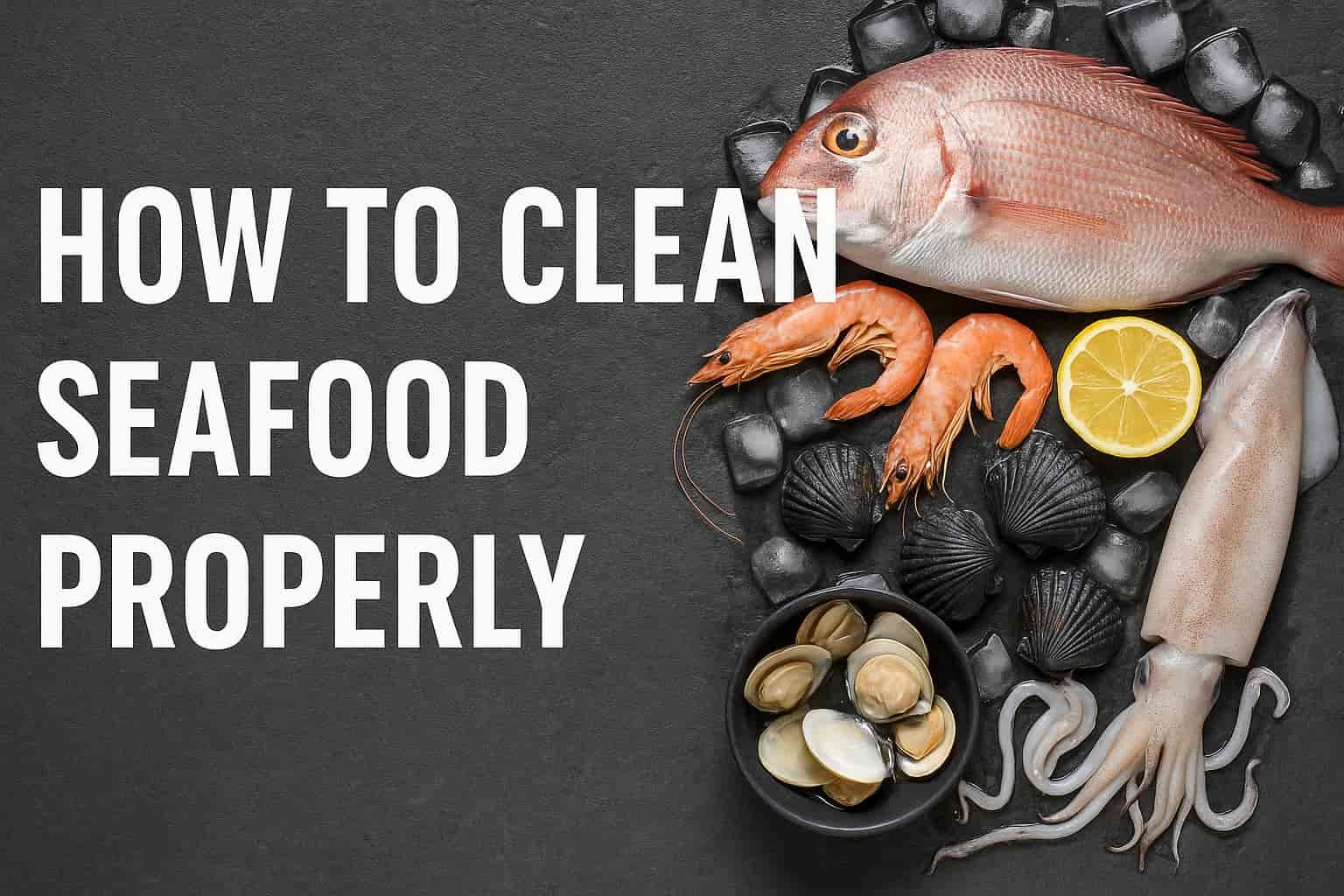Properly cleaning seafood is essential to eliminate harmful bacteria, parasites, and chemical residues that can compromise food safety and health. According to the Food and Agriculture Organization (FAO), over 50% of seafood-related foodborne illnesses result from improper handling and cleaning. Beyond health concerns, thorough cleaning enhances the natural flavors and preserves the delicate texture of seafood, ensuring the best culinary results.
For home cooks, mastering seafood cleaning techniques is a critical skill that guarantees both safety and taste. This guide provides specific, step-by-step instructions tailored to different types of seafood, helping you avoid common mistakes and ensure every meal is fresh, flavorful, and safe to eat.
Contents
- 1 What Are the Common Types of Seafood That Require Special Cleaning Methods?
- 2 How Do You Properly Clean Fresh Fish at Home?
- 3 How Do You Clean Shellfish Like Clams, Mussels, and Oysters Safely?
- 4 What Is the Best Method to Clean Shrimp, Crabs, and Lobsters?
- 5 How Should You Clean Squid and Octopus for Cooking?
- 6 What Tools and Equipment Help Clean Seafood More Effectively?
- 7 How Do You Ensure Food Safety While Cleaning Seafood?
- 8 How Do Professional Chefs Clean Seafood Differently?
- 9 How Should You Store Cleaned Seafood Before Cooking?
What Are the Common Types of Seafood That Require Special Cleaning Methods?
There are four main categories of seafood that demand distinct cleaning approaches: fish, shellfish, crustaceans, and cephalopods.
- Fish: Species such as salmon, mackerel, and cod require descaling, gutting, and odor removal.
- Shellfish: Clams, mussels, and oysters must be purged of sand and checked for spoilage.
- Crustaceans: Shrimp, crabs, and lobsters involve shell removal, deveining, and careful preparation to preserve meat quality.
- Cephalopods: Squid and octopus need complete organ removal and, in some cases, tenderizing before cooking.
How Do You Properly Clean Fresh Fish at Home?
To properly clean fresh fish, start by removing scales, gutting the fish completely, and eliminating any lingering odors.
- Remove Scales:
- Use a fish scaler or the back of a knife.
- Start from the tail and move towards the head.
- Rinse thoroughly under cold water to remove all loose scales.
- Gut the Fish:
- Insert a sharp knife along the belly from the anus to the gills.
- Remove all internal organs carefully.
- Rinse the cavity under running water until no blood or residue remains.
- Odor Removal:
- Rub the fish with a mixture of salt and lemon juice.
- Rinse again with cold water to neutralize any remaining odors.
Tip: Always use a separate cutting board for seafood to prevent cross-contamination.
How Do You Clean Shellfish Like Clams, Mussels, and Oysters Safely?
To clean shellfish safely, you must purge sand, check for spoilage, and scrub the shells thoroughly.
- Purge Sand from Clams and Mussels:
- Soak them in a solution of 1 liter of water with 30 grams of salt for 30–60 minutes.
- Repeat the process twice to ensure complete sand removal.
- Check for Spoiled Shellfish:
- Tap any open shells; discard them if they don’t close.
- Discard any shellfish with cracked or broken shells.
- Clean Oysters Before Shucking:
- Scrub the shells under running water using a stiff brush.
- Remove all mud and debris before attempting to shuck.
What Is the Best Method to Clean Shrimp, Crabs, and Lobsters?
To clean shrimp, crabs, and lobsters effectively, remove inedible parts, devein shrimp properly, and handle crustaceans carefully to retain meat quality.
How to Remove Shrimp Shells and Veins Efficiently?
- Remove Shells:
- Hold the shrimp firmly and peel off the shell starting from the head end.
- Leave the tail on for presentation if desired.
- Devein the Shrimp:
- Use a paring knife to make a shallow cut along the back.
- Remove the black vein using the knife tip or rinse it out under cold water.
Note: The vein is the digestive tract and contains waste; removing it improves both hygiene and flavor.
How to Properly Clean and Prepare Live Crabs for Cooking?
- Stun the Crab First:
- Place it in ice water for 15 minutes to immobilize it before cleaning.
- Remove the Apron and Shell:
- Lift the apron (the flap on the underside) and remove it.
- Detach the top shell and discard the gills (also known as dead man’s fingers).
- Clean the Cavity:
- Rinse out any internal debris under running cold water.
How Do You Clean Lobsters Without Damaging the Meat?
- Kill Humanely Before Cleaning:
- Freeze the lobster for 15–20 minutes before cooking to minimize suffering.
- Separate the Tail and Claws:
- Twist and pull firmly to separate body parts.
- Remove Intestine and Sac:
- Cut the tail along the top to remove the vein.
- Discard the small sac behind the lobster’s eyes, which contains inedible material.
How Should You Clean Squid and Octopus for Cooking?
Cleaning squid and octopus requires complete removal of internal organs and non-edible parts to achieve a clean, tender result.
How to Remove Squid Skin, Ink Sac, and Beak Properly?
- Remove the Head and Innards:
- Hold the body firmly and pull out the head and internal organs in one motion.
- Extract the Ink Sac Carefully:
- Set aside if you plan to use the ink; otherwise, discard it immediately.
- Remove the Beak:
- Locate the beak at the base of the tentacles and press it out.
- Peel Off the Skin:
- Use your fingers to peel the skin from the body and fins for a cleaner presentation.
Is Tenderizing Octopus Part of the Cleaning Process?
Yes, tenderizing is essential to soften the tough muscle fibers.
- Use a meat mallet to pound the octopus lightly for 5–10 minutes.
- Alternatively, freeze the octopus for at least 24 hours, which naturally breaks down muscle fibers.
Pro Tip: Rinse the octopus thoroughly after tenderizing to remove any residual slime.
What Tools and Equipment Help Clean Seafood More Effectively?
Essential seafood cleaning tools improve precision, speed, and safety during the cleaning process.
- Scalers: Remove fish scales quickly without damaging the skin.
- Fillet Knives: Thin, sharp blades allow for precise cutting and filleting.
- Kitchen Shears: Ideal for cutting through tough shells of crustaceans.
- Scrubbing Brushes: Used to clean shells of mussels, clams, and oysters thoroughly.
- Cutting Boards: Designate a separate board for seafood to prevent cross-contamination.
- Gloves: Protect hands from sharp shells and fish spines while ensuring hygiene.
Tip: Keep all tools sanitized before and after use to maintain food safety standards.
How Do You Ensure Food Safety While Cleaning Seafood?
To ensure food safety during seafood cleaning, maintain strict hygiene practices, control temperature, and discard any seafood that shows spoilage signs.
- Prevent Cross-Contamination:
- Always use separate cutting boards for seafood and other food items.
- Disinfect surfaces and tools with a solution of 1 tablespoon of bleach per gallon of water after handling raw seafood.
- Control Temperature:
- Keep seafood chilled at or below 4°C (39.2°F) before cleaning.
- Limit seafood exposure to room temperature to under 1 hour.
- Discard Unsafe Seafood:
- Throw away seafood with an off-putting ammonia smell.
- Avoid consuming any seafood with unusual discoloration, sticky textures, or slimy surfaces.
Tip: Always wash your hands thoroughly with soap for at least 20 seconds after handling raw seafood.
How Do Professional Chefs Clean Seafood Differently?
Professional chefs apply precise, efficient techniques to preserve seafood texture, enhance presentation, and minimize waste.
- Use of Specialized Tools:
- High-grade fillet knives with flexible blades improve cutting accuracy.
- Fine tweezers remove pin bones from fillets without damaging flesh.
- Time-Efficient Cleaning Methods:
- Chefs perform “butterfly” cuts on shrimp to speed up deveining.
- They use quick purging methods like adding cornmeal to purge clams faster.
- Maintaining Presentation Quality:
- Chefs often leave the tail on shrimp for visual appeal.
- They ensure perfect cuts on fish fillets to avoid uneven thickness, improving cooking consistency.
Tip: Adopting professional techniques reduces preparation time by up to 30% while achieving superior results.
How Should You Store Cleaned Seafood Before Cooking?
Store cleaned seafood immediately under optimal conditions to maintain freshness and prevent bacterial growth.
- Refrigeration:
- Place cleaned seafood in an airtight container or sealed plastic bag.
- Store at 0–4°C (32–39.2°F) and consume within 1–2 days for best quality.
- Freezing:
- For longer storage, freeze seafood at -18°C (0°F) or lower.
- Vacuum sealing extends shelf life and prevents freezer burn.
- Storage Tips:
- Use crushed ice beds in the refrigerator for fish to maintain optimal cold temperatures.
- Label containers with the date of cleaning to track freshness accurately.
Pro Tip: Avoid washing seafood before freezing; instead, clean it thoroughly after thawing to preserve texture.



